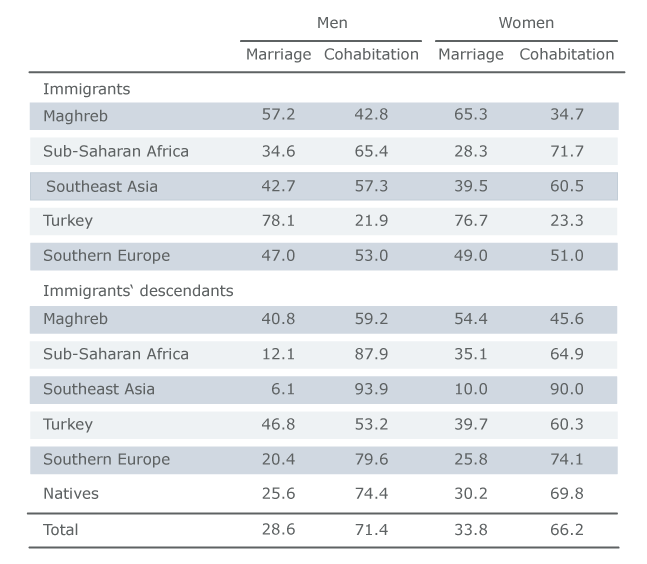During the past 50 years, marital trends in Europe have changed significantly, particularly in France, where family formation has been postponed, the number of marriages has declined and cohabitation has increased. Simultaneously, for some time now, France has been a country of immigration, welcoming immigrants from a wide variety of countries and regions where partnership patterns are highly diverse. How are these two trends connected? In her study, Ariane Pailhé compares partnership dynamics between immigrants and the native French population. Using data from the Trajectories and Origins (TeO) survey, she explores whether the change in family patterns among the French population have taken place among first and second generation immigrants, as well as across immigrant groups.
Origin-related disparities
The study shows that immigrants generally enter into their first union later than the native French population. However, this finding varies considerably across immigrant groups.
Immigrants from the Maghreb, Southeast Asia and especially Sub-Saharan Africa tend to form their first union much later than native French: Around six years later for Sub-Saharan African immigrants and four years later for immigrants from the Maghreb. In comparison, first generation immigrants from Southern Europe and Turkey do not differ from their native French counterparts.
The country of origin influences union formation not just in terms of timing, but also in terms of the type of union. For instance, while around 70% of French men and women prefer cohabitation, direct marriage still remains more common for Turkish immigrants with more than three out of four marrying directly. In contrast, only about one-third of first generation Sub-Saharan Africans marry directly (Table 1).

Table 1: Type of first union, by origin and sex (%)
Source: Calculations based on Trajectories and Origins survey (TeO), INED-INSEE, 2008
A matter of generation and gender
Discrepancies in partnership dynamics are not just appearing across countries of origin, but also across generations and sexes. Across generations, lower levels of direct marriage for the second generation of immigrants are observed, while the level of cohabitation is increasing. This particularly applies to immigrant families from Southeast Asia: Whereas around 40% of the immigrants start their families by getting married, around 90% of their descendants choose to cohabitate first. However, even if these results highlight a convergence of partnership patterns towards the prevailing French behaviour, direct marriage still remains the common pathway for the descendants from the Maghreb countries und Turkey.
Considering all countries and both generations, the analysis indicates that female immigrants form their first union earlier than their male counterparts, and direct marriage is more frequent. Nevertheless, relative to the French natives, the results show a larger postponement of the first union for both men and women.
Structural versus cultural factors
Convergence towards French partnership dynamics seems to be higher for immigrants coming from societies whose cultural standards are similar to the French one. By considering socio-economic and cultural influences, direct marriage appears to be related to having a lower socio-economic status and stronger religious convictions, especially for both generations of Turkish immigrants. Higher levels of education decreases the likelihood of immigrants to marry directly, but it does not change their timing of cohabitation.
To conclude, even if some results indicate that second generation immigrants have more choice regarding their lifestyle and personal arrangements, they continue to be influenced by the marital practices of their parents to some extent. Pailhé puts this into perspective, though: “It took several generations for cohabitation to diffuse in European countries, and not surprisingly it will take time for immigrants’ descendants to adopt such behavior”.

*This PopDigest has received funding from the European Union's Seventh Framework Programme (FP7/2007-2013) under grant agreement n° 320116 for the research project FamiliesAndSocieties. FamiliesAndSocieties (www.familiesandsocieties.eu) has the aim to investigate the diversity of family forms, relationships and life courses in Europe, to assess the compatibility of existing policies with these changes, and to contribute to evidence-based policy-making. The consortium brings together 25 leading universities and research institutes in 15 European countries and three transnational civil society organizations.